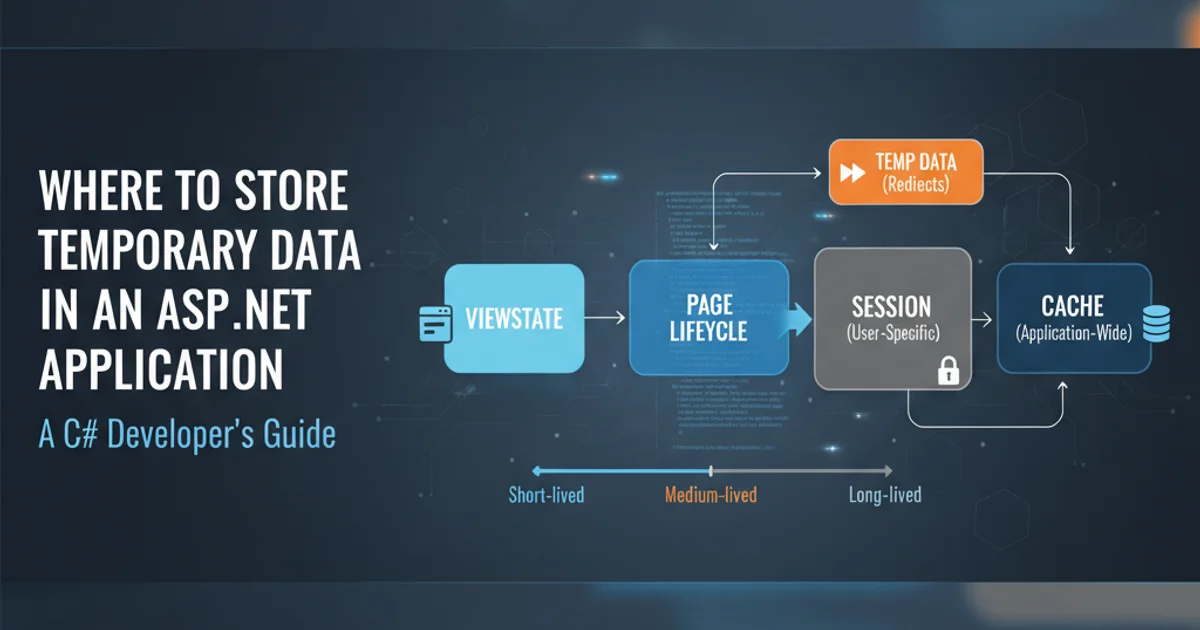Where to store temporary data in an ASP.NET application
Categories:
Where to Store Temporary Data in Your ASP.NET Application

Navigate the various options for temporary data storage in ASP.NET, understanding the trade-offs between ViewState, Session, TempData, Cache, and Application state for optimal performance and user experience.
In ASP.NET development, managing temporary data is a common challenge. Whether you need to preserve user input across postbacks, maintain state across multiple requests, or store frequently accessed data for performance, choosing the right storage mechanism is crucial. This article explores the primary options available in ASP.NET for temporary data storage, detailing their use cases, advantages, and disadvantages.
Understanding ASP.NET State Management Options
ASP.NET provides several built-in mechanisms for managing state, each designed for different scenarios. The choice depends on the data's scope (single page, single user, all users), its lifetime, and its sensitivity. Let's break down the most common options.
flowchart TD
A[User Request] --> B{Data Needed Across?}
B -- Yes --> C{Single Page Postback?}
C -- Yes --> D[ViewState]
C -- No --> E{Single User, Multiple Pages?}
E -- Yes --> F[Session State]
E -- No --> G{Next Request Only?}
G -- Yes --> H[TempData]
G -- No --> I{All Users, Frequent Access?}
I -- Yes --> J[Application State / Cache]
I -- No --> K[Database / External Store]
B -- No --> L[No State Management Needed]Decision flow for choosing ASP.NET temporary data storage
ViewState: Page-Specific Data Persistence
ViewState is a page-level state management mechanism used to preserve the state of server controls and custom data between postbacks for the same page. It's stored in a hidden field on the page itself, transmitted to the client, and sent back to the server with each request. This makes it stateless from the server's perspective but stateful for the client.
protected void Page_Load(object sender, EventArgs e)
{
if (!IsPostBack)
{
// Initialize ViewState on first load
ViewState["MyData"] = "Initial Value";
}
else
{
// Retrieve ViewState on postback
string data = ViewState["MyData"] as string;
Response.Write($"<p>Data from ViewState: {data}</p>");
ViewState["MyData"] = "Updated Value"; // Update for next postback
}
}
Example of using ViewState in an ASP.NET Web Forms page
Session State: User-Specific Data Across Requests
Session State allows you to store user-specific data that persists across multiple requests within a single user's session. This data is typically stored on the server and is identified by a unique session ID, which is usually passed via a cookie. Session State is ideal for storing user preferences, shopping cart contents, or authentication details.
protected void Login_Click(object sender, EventArgs e)
{
// Store user ID in session after successful login
Session["UserID"] = "john.doe";
Session["LastLogin"] = DateTime.Now;
}
protected void DisplayUserInfo(object sender, EventArgs e)
{
if (Session["UserID"] != null)
{
string userId = Session["UserID"] as string;
DateTime lastLogin = (DateTime)Session["LastLogin"];
Response.Write($"<p>Welcome back, {userId}! Your last login was {lastLogin}.</p>");
}
else
{
Response.Write("<p>Please log in.</p>");
}
}
Storing and retrieving data using Session State
TempData: Data for the Next Request Only
TempData is a specialized dictionary that stores data for a very short duration – typically for the current request and the subsequent request. It's commonly used in ASP.NET MVC and Razor Pages to pass data between controller actions or between a redirect and the target view. After the data is read, it's automatically marked for deletion.
TempData.Keep() or TempData.Peek() to prevent it from being marked for deletion after being read.// In a Controller Action (e.g., after a form submission)
public IActionResult CreateUser(UserViewModel model)
{
if (ModelState.IsValid)
{
// ... save user ...
TempData["Message"] = "User created successfully!";
return RedirectToAction("Index");
}
return View(model);
}
// In the target View (e.g., Index.cshtml)
@if (TempData["Message"] != null)
{
<div class="alert alert-success">
@TempData["Message"]
</div>
}
Using TempData to pass a success message after a redirect
Application State and Cache: Global Data for All Users
Application State (HttpContext.Current.Application) provides a way to store data that is accessible to all users across the entire application. It's useful for global counters, application-wide settings, or data that rarely changes. However, it's not recommended for large amounts of data due to memory consumption and lack of expiration.
For more sophisticated global data management, ASP.NET's Cache object (HttpContext.Current.Cache) is preferred. It allows you to store data with expiration policies (absolute or sliding), dependencies, and callbacks, making it ideal for caching frequently accessed but relatively static data like lookup tables or configuration settings.
// Using Application State
protected void Application_Start(object sender, EventArgs e)
{
Application["VisitorCount"] = 0;
}
protected void Session_Start(object sender, EventArgs e)
{
Application.Lock();
Application["VisitorCount"] = (int)Application["VisitorCount"] + 1;
Application.UnLock();
}
// Using Cache
protected void Page_Load(object sender, EventArgs e)
{
string cachedData = Cache["MyCachedItem"] as string;
if (cachedData == null)
{
// Data not in cache, retrieve it and add to cache
cachedData = "Data loaded at " + DateTime.Now.ToLongTimeString();
Cache.Insert(
"MyCachedItem",
cachedData,
null,
DateTime.Now.AddMinutes(5), // Absolute expiration in 5 minutes
Cache.NoSlidingExpiration
);
}
Response.Write($"<p>Cached Data: {cachedData}</p>");
}
Examples of Application State and Cache usage